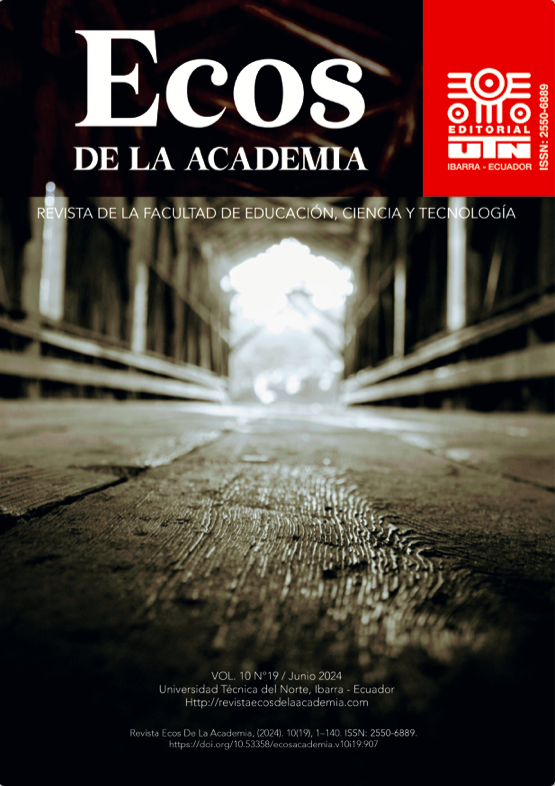Articulation between the plastic arts and creative writing in vulnerable children Red de Escritores de Medellín Project
Main Article Content
Abstract
The investigation is presented, based on research on creative writing, based on reflections and conclusions arising from the axis of interdisciplinarity as a method of incentive and stimulation of communication skills (reading, writing, listening and speaking), during the Red de Escritores Ciudad de Medellín program. In this dialogue, dynamic strategies of approach are projected in these groups, in order to avoid revictimization, stigma, and propose ways of expression, strokes, creative writing and music, in discursive consonance with the realities, based on the contributions of Rodari, Cassany and others, based on various programs with support from the public sector, in settings such as prisons, educational units, foundations and cultural centers. Likewise, through these considerations, critical thinking is stimulated as a dynamic of daily questioning that tends towards an articulation between self-knowledge and the self-worth of individuals as subjects of rights.
Downloads
Article Details

This work is licensed under a Creative Commons Attribution-NonCommercial-ShareAlike 4.0 International License.
The authors transfer the publication rights to the journal in all its formats and digital media.
Regarding Copyright CC BY-NC-SA 4.0, this journal is under a license of https://creativecommons.org/licenses/by-nc-sa/4.0/.
You are free to:
Share: copy and redistribute the material in any medium or format
Adapt: remix, transform, and build upon the material
The licensor cannot revoke these freedoms as long as you follow the license terms.
Under the following terms:
1. Attribution: You must give appropriate credit, provide a link to the license, and indicate if changes were made. You may do so in any reasonable manner, but not in any way that suggests the licensor endorses you or your use.
2.Non-Commercial:You may not use the material for commercial purposes.
3. ShareAlike: If you remix, transform, or build upon the material, you must distribute your contributions under the same license as the original.
4.No additional restrictions: You may not apply legal terms or technological measures that legally restrict others from doing anything the license permits.
Notices:
You do not have to comply with the license for elements of the material in the public domain or when your use is permitted by an applicable exception or limitation.
No warranties are given. The license may not grant you all the permissions necessary for your intended use. For example, other rights such as publicity, privacy, or moral rights may limit how you use the material.
LEGAL CODE CC BY-NC-SA 4.0
References
Álvarez-Galeano, M. F. (2023). Neoliberalismo, periferia y crecimiento urbano de Medellín: 1980-2023: Neoliberalism, periphery and urban growth of Medellín: 1980-2023. Revista Científica Ecociencia, 10(4), 88–109. https://doi.org/10.21855/ecociencia.104.839 DOI: https://doi.org/10.21855/ecociencia.104.839
Asamblea Nacional Constituyente. (1991). Constitución Política de Colombia. Centro de Documentación Judicial.
Calvino, I. (2023). Ciudades invisibles. Siruela.
Cassany, D., y Castellà, J. M. (2011). Aproximación a la literacidad crítica. Perspectiva. 2011; 28 (2): 353-374. https://repositori.upf.edu/bitstream/handle/10230/21187/Cassany_PERSPECTIVA_28_2.pdf?sequence=1&isAllowed=y DOI: https://doi.org/10.5007/2175-795X.2010v28n2p353
De Saint-Exupéry, A. (2018). El Principito. Veta Ediciones.
Erro, A. (2000). La ilustración en la literatura infantil. RILCE: Revista de filología hispánica, 16(3), 501-511. DOI: https://doi.org/10.15581/008.16.26774
Galeano, E. (2010). El libro de los abrazos. Siglo XXI.
Henley, W. E. (1974). Invictus. En: J. Ferrer-Vidal. Los poemas hospitalarios de WE Henley. Jano: Medicina y humanidades, (123), 123-123.
Lavoe, H. (2018). Juanito Alimaña [archivo de video]. Youtube. https://www.youtube.com/watch?v=Evl18kT8LqQ
Llorens García, R. F. (2000). Literatura infantil y valores. Puertas a la lectura, (9), 76. https://dialnet.unirioja.es/descarga/articulo/206248.pdf
Martínez, A. (1999). Vida y literatura. Identidad personal e identidad del personaje. Thémata, 23, 271-276. https://idus.us.es/bitstream/handle/11441/27482/file_1.pdf?sequence=1
Martínez Ramírez, R. E., Rodríguez Benavides, Á. J., y Sáenz Escobar, M. C. (2019). Literatura, lúdica y tic en la promoción de las habilidades comunicativas [tesis de maestría, Universidad de Cartagena]. https://repositorio.unicartagena.edu.co/bitstream/handle/11227/11311/0487.pdf?sequence=1&isAllowed=y
Monsalve Upegui, E. M., Franco Velásquez, M. A., Ríos, M. A., Betancur Trujillo, V. L. y Ramírez Salazar, D. A. (2009). Desarrollo de las habilidades comunicativas en la escuela nueva. Revista Educación y Pedagogía, (55), 189-210. https://revistas.udea.edu.co/index.php/revistaeyp/article/download/9766/8979/
Moral Anel, S. (2018). La ilustración en la literatura infantil: una aportación en primera persona [tesis de titulación, Universidad de Valladolid]. https://uvadoc.uva.es/handle/10324/32359
Paladines, L., y Álvarez-Galeano, M. F. (2022). La enseñanza de la Lengua y la Literatura en tiempos de pandemia en la Región Sur de Ecuador. Revista de Educación, (25.1), 379-395. https://fh.mdp.edu.ar/revistas/index.php/r_educ/article/view/5863
Pink Floyd. (2023). Brain Damage [archivo de video]. Youtube. https://www.youtube.com/watch?v=QFdkM40KOhE
Rama, A. (1998). La ciudad letrada. Arca
Reyes, T. (1999). Métodos cualitativos de investigación: los grupos focales y el estudio de caso. In Forum empresarial (Vol. 4, No. 1, pp. 74-87). Universidad de Puerto Rico. https://dialnet.unirioja.es/descarga/articulo/6230192.pdf DOI: https://doi.org/10.33801/fe.v4i1.2892
Rodari, G. (2004). La imaginación en la literatura infantil. Imaginaria: revista quincenal de literatura infantil, N° 125, párr. 3. https://www.imaginaria.com.ar/12/5/rodari2.htm
Rodari, G. (2017). Escuela de fantasía. Reflexiones sobre educación para profesores, padres y niños. Blackie Books.
Rodríguez López, J. (1991). El método explicativo en las epistemologías regionales de la actividad física. Apunts. Educación física y deportes, 2(24), 19-26. https://www.raco.cat/index.php/ApuntsEFD/article/download/381297/474409
Sierra Jaramillo, L. G., Borges, J., Granata, L. M., Kafka, F., Giorgio, M. D., Pund, E., ... y Tabalado, J. J. (2017). Animales en la poesía: selección de poemas. Editorial Universidad de Antioquia.
Tabash Blanco, N. (2002). La lectura creativa: propuestas para fortalecer la expresión escrita. Revista Electrónica Educare, (2), 99-111. https://www.revistas.una.ac.cr/index.php/EDUCARE/article/download/958/15480 DOI: https://doi.org/10.15359/ree.2002-2.8
Troncoso, M. (1992). El poema espacio donde la otredad manifiesta la trascendencia. Universitas Humanística, 36(36), 40.
Villarini Jusino, Á. R. (2003). Teoría y pedagogía del pensamiento crítico [archivo PDF]. Perspectivas psicológicas, 3(4), 35-42. https://www.academia.edu/download/46916511/Teoria_y_Pedagogia_del_pensamiento_critico.pdf
Zaldívar Sansuán, R. (2016). El desarrollo de la conciencia emocional en la adolescencia a través de la poesía [tesis de maestría, Universidad Complutense de Madrid]. https://n9.cl/x7lu6





